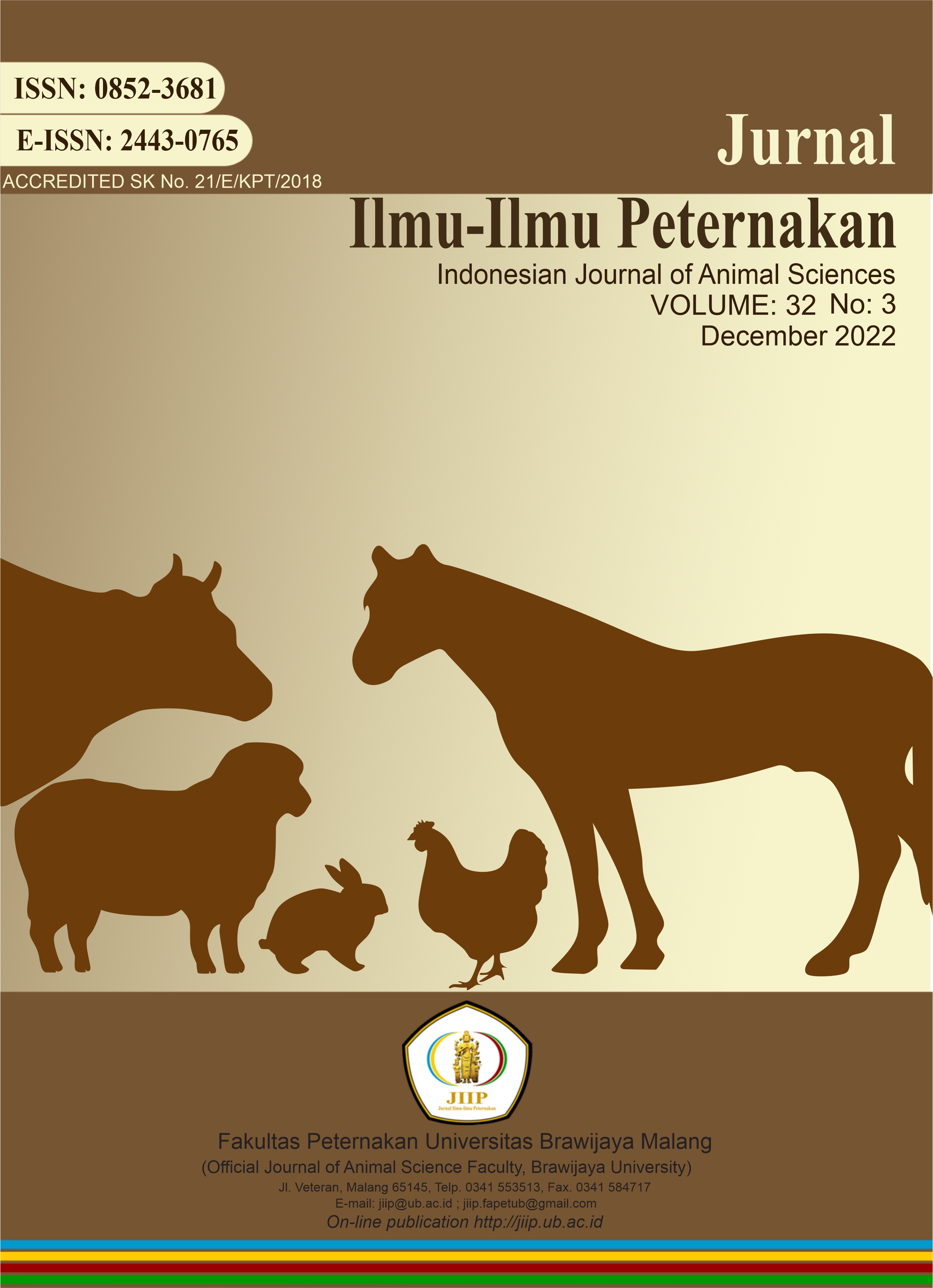The Effect of Feeding with Different Percentages of Energy on the Growth Performance of Jowo Super Chicken
DOI:
https://doi.org/10.21776/ub.jiip.2022.032.03.10Keywords:
Jowo super chickens, Feed intake, Body weight, Body weight gain, FCR, Mortality, Index performanceAbstract
This study aims to determine the different levels both metabolic energy and protein treatments on growth performance of Jowo Super (JOPER) chickens. A total of 192 one-day-old chicks Jowo Super chickens (unsexed) were used in twelve-week trials. Prior to statistical analysis using analysis of variances (Anova) where least significance differences subjected using Duncan Multiple Test. The different levels of treatments on growth performance was not significance differ (p > 0.05). In summary, the metabolizable energy was recommended at 2880 kcal/kg (starter periods) and 2,950 kcal/kg (finisher). Feed intake, body weight gain, feed conversion ratio, and mortality was best in the 1707.17; 744.25; 2.53; 699.75, respectively.
References
Ajibah, B. N., Winurdana, A. S., dan Sudani, E. T. 2020. Perbedaan Pemberian Onggok Terfermentasi Trichoderma viride terhadap Penampilan Produksi Ayam Kampung Super (Gallus domesticus sp). AVES: Jurnal Ilmu Peternakan. 14(1): 1–10. https://doi. org/10.35457/aves.v14i1.1487
Amiruddin., Agustina, L dan Jamilah, J. 2020. Konsumsi Pakan, Konversi Pakan dan
Produksi Telur Ayam Arab Yang Ditambahkan Tepung Daun Murbei Pada Pakan.
Buletin Nutrisi dan Makanan Ternak. 14 (1): 43–51. https://doi.org/10.20956/ bnmt.v14i1.10583
Anggraini, A. D., Widodo, W., Rahayu, I. D., dan Sutanto, A. 2019. Efektivitas Penambahan Tepung Temulawak dalam Ransum sebagai Upaya Peningkatan Produktivitas Ayam Kampung Super. Jurnal Sain Peternakan Indonesia. 14(2): 222–227. https://doi.org/10.31186/jspi.id. 14.2.222-227
Kusriningrum. 2008. Perancangan Percobaan. Airlangga University Press. Surabaya.pp 3245.
Ma’rifah, B., Atmomarsono, U., and Suthama, N. 2013. Nitrogen Retention and Productive Performance of Crossbred Native Chicken Due to Feeding Effect of Kayambang (Salvinia molesta). International Journal of Science and Engineering. 5(1): 19–23. https://doi.org/10.12777/ ijse.5.1.19-24
Mubarak, P. R., Mahfudz, L. D., and Sunarti, D. 2019. Pengaruh Pemberian Probiotik pada Level Protein Pakan Berbeda terhadap Perlemakan Ayam Kampung. Jurnal Sain Peternakan Indonesia, 13(4), 357–364. https://doi. org/10.31186/jspi.id.13.4.357-364
NRC. National Research Council, 1994. 2004. Diet requirements for poultry. 9th End. (Washington supplied with L-lysine and L-arginine during chronic. DC.National Academy Press).
Pakaya, S. A., dan Zainudin, S. 2019. Performa Ayam Kampung Super yang di Beri Level Penambahan Tepung Kulit Kakao (Theobroma cacao, L.) Fermentasi dalam Ransum.
Jambura Journal of Animal Science. 1(2): 40–45. https://doi.org/10.35900/jjas. v1i2.2603
Rianza, R., D. Rusmana, dan W. Tanwiriah. 2019. Penggunaan Ampas Sagu Fermentasi Sebagai Pakan Ayam Kampung Super Fase Starter. Jurnal Ilmu Ternak. 19(1): 36-44.
Sundu, B., and Syukur, S. H. 2018. Indeks Performans (IP) dan Income Over Feed and Chick Cost (IOFCC) Penggunaan Biji Akasia Duri (Acacia nilotica (L.) Willd. ex Del.). Mitra Sains. 73–81.
Syaikhullah, G., Darwati, S., dan Sumantri, C. 2017. Asosiasi Keragaman Growth Hormone Secretagogue Receptor (GHSR | Hin6i) terhadap Bobot Karkas Ayam Kampung pada
Umur 12 Minggu. Jurnal Ilmu Produksi Dan Teknologi Hasil Peternakan. 5(3): 117–121. https://doi.org/10.29244/jip thp.5.3.117-121
Woro, I. D., Atmomarsono, U., dan Muryani, R. 2019. Pengaruh Pemeliharaan pada Kepadatan Kandang yang Berbeda Terhadap Performa Ayam Broiler. Jurnal Sain Peternakan Indonesia. 14(4): 418–423. https://doi.org/10.31186/jspi.id. 14.4.418-423
Downloads
Published
How to Cite
Issue
Section
License
Copyright (c) 2022 Muhammad Halim Natsir

This work is licensed under a Creative Commons Attribution-NonCommercial-ShareAlike 4.0 International License.
Authors who publish with this journal agree to the following terms:- Authors retain copyright and grant the journal right of first publication with the work simultaneously licensed under a Creative Commons Attribution License that allows others to share the work with an acknowledgment of the work's authorship and initial publication in this journal.
- Authors are able to enter into separate, additional contractual arrangements for the non-exclusive distribution of the journal's published version of the work (e.g., post it to an institutional repository or publish it in a book), with an acknowledgment of its initial publication in this journal.
- Authors are permitted and encouraged to post their work online (e.g., in institutional repositories or on their website) prior to and during the submission process, as it can lead to productive exchanges, as well as earlier and greater citation of published work (See The Effect of Open Access).
















